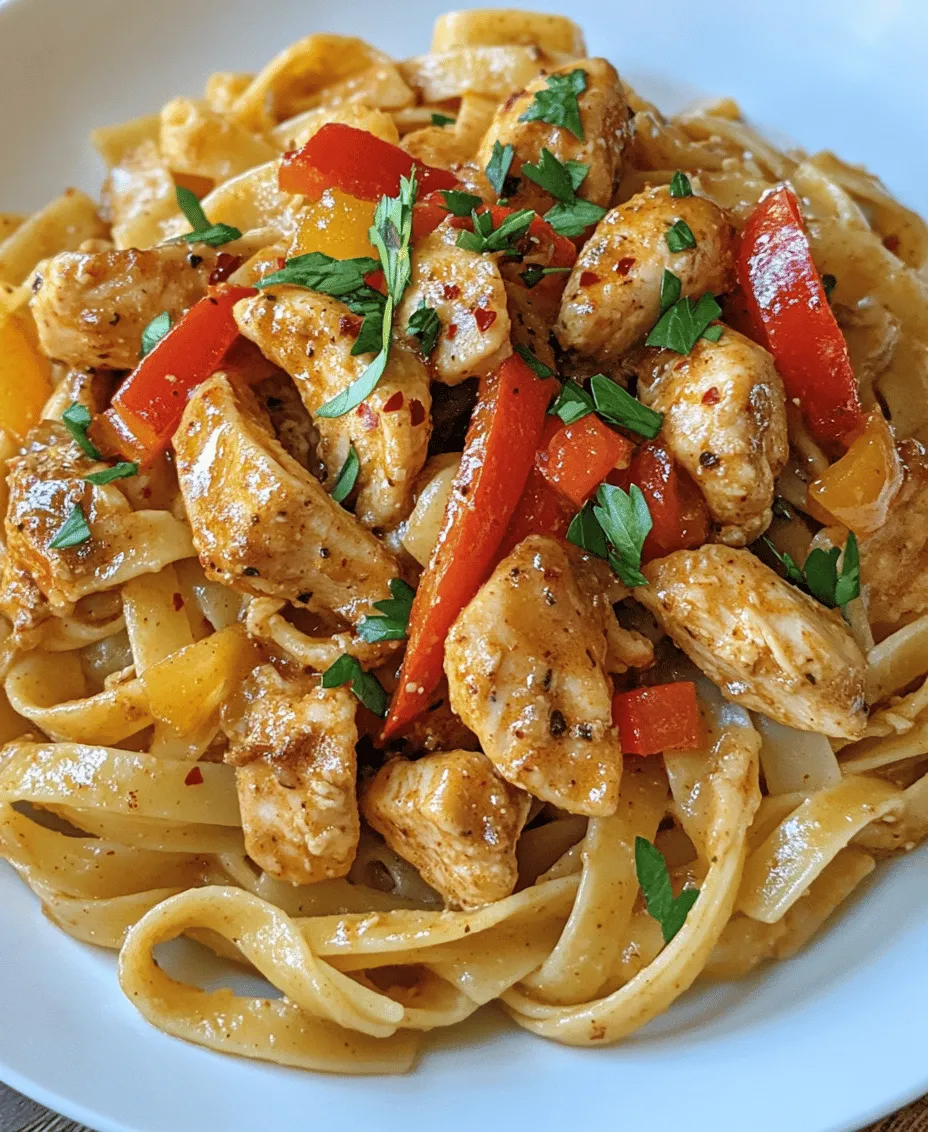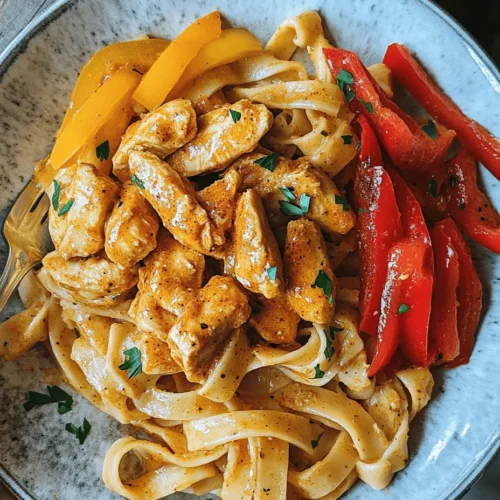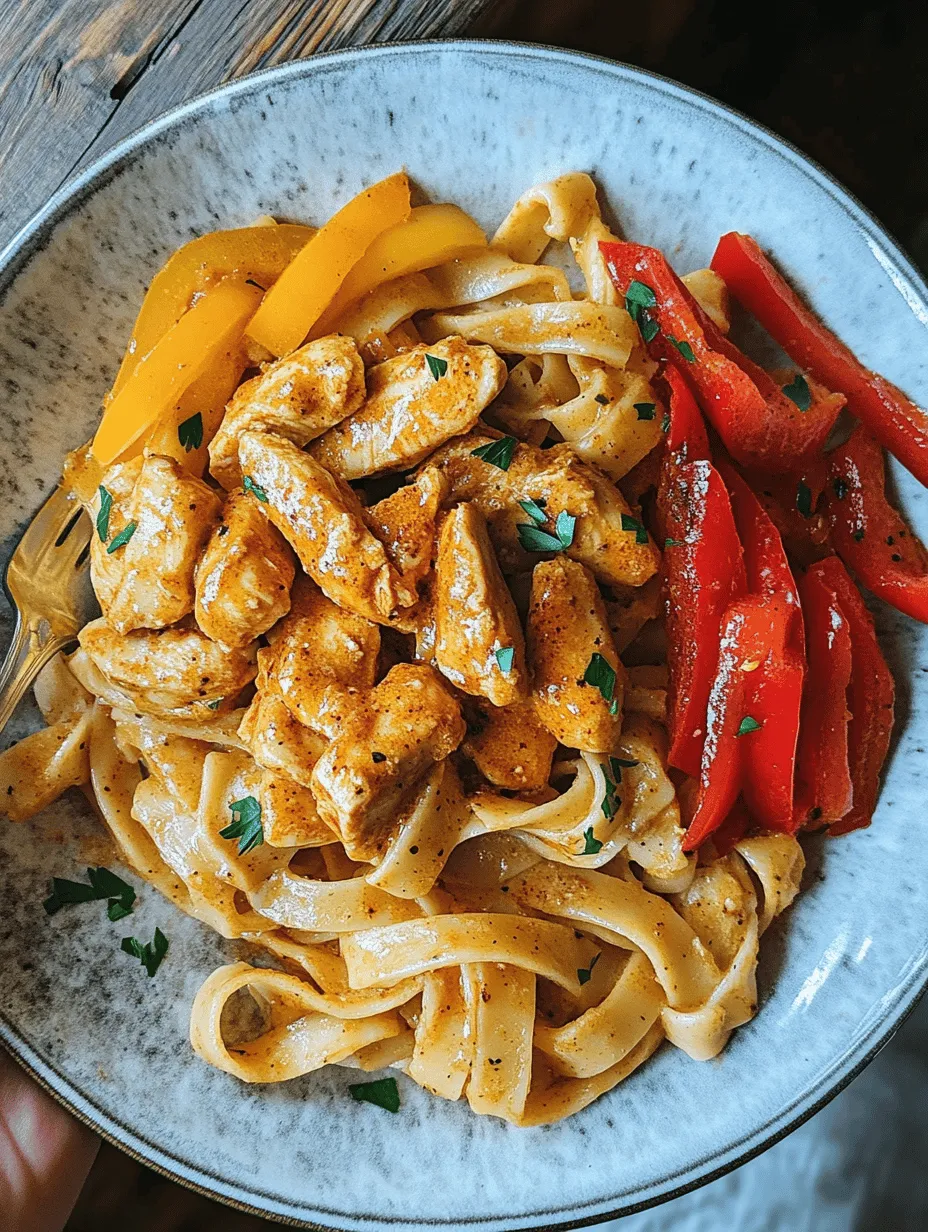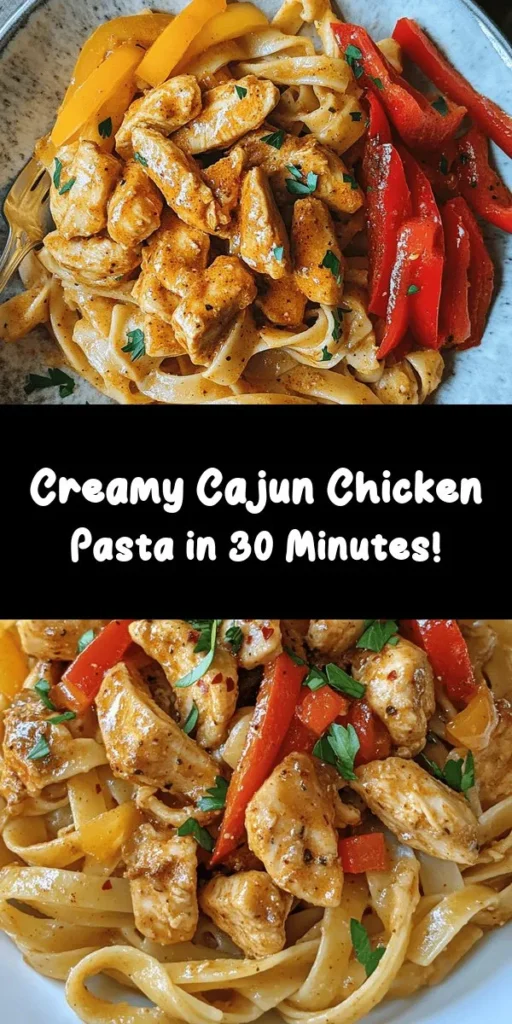Introduction
There’s an undeniable allure to creamy pasta dishes that makes them a staple in kitchens around the world. Among the myriad of options available, Creamy Cajun Chicken Pasta stands out with its vibrant flavors, comforting texture, and the delightful kick of spice that keeps you coming back for more. This dish artfully marries the rich, luscious cream sauce with the zesty and bold notes of Cajun seasoning, making it an ideal choice for family dinners, special gatherings, or simply a cozy night in.
Whether you’re a seasoned cook or a culinary novice, this recipe offers a straightforward yet rewarding cooking experience. In this article, we will dive deep into the ingredients that create this masterpiece, the preparation process, and the cultural influences that make Creamy Cajun Chicken Pasta a beloved dish among food enthusiasts. Get ready to tantalize your taste buds and impress your guests with this delightful meal.
Overview of Creamy Cajun Chicken Pasta
Creamy Cajun Chicken Pasta is more than just a dish; it’s an experience that encompasses the rich heritage of Cajun cuisine. Originating from the French-speaking Acadian people in Louisiana, Cajun food is characterized by its bold flavors and use of spices, making it a culinary celebration of culture and tradition. The creamy pasta variation adds a contemporary twist to this classic, merging the hearty essence of Italian cuisine with the zest of Cajun flavors.
One of the reasons this dish resonates with so many food lovers is its perfect balance of flavors. The creaminess of the sauce perfectly complements the spice of the Cajun seasoning, while the tender chicken and al dente pasta provide a satisfying texture. Each bite is a harmonious blend of richness and zest, making it a crowd-pleaser that invites seconds and thirds.
Ingredients Breakdown
Creating the perfect Creamy Cajun Chicken Pasta requires a selection of quality ingredients that each contribute to the overall flavor and texture of the dish. Let’s explore each component in detail, highlighting their roles and benefits.
The Pasta: Fettuccine
Fettuccine is often the pasta of choice for creamy sauces due to its broad, flat shape which allows it to hold onto the sauce beautifully. When cooked to al dente perfection, fettuccine provides a satisfying bite that complements the richness of the creamy sauce. The pasta serves as a canvas, absorbing the flavors of the ingredients while providing a hearty base for the dish.
The Chicken: Boneless, Skinless Chicken Breasts
Boneless, skinless chicken breasts are ideal for this recipe as they cook quickly and absorb flavors effectively. Their mild taste allows the Cajun seasoning to shine through, while their tender texture adds a satisfying protein element to the dish. Opting for this cut also makes the dish lighter and healthier, appealing to those who are mindful of their dietary choices.
Cajun Seasoning: The Heart of the Dish
Cajun seasoning is the star of this recipe, delivering the distinctive flavor profile that defines this dish. A blend of spices including paprika, cayenne pepper, garlic powder, onion powder, thyme, and oregano, Cajun seasoning adds a warm, spicy kick that elevates the entire meal. The heat level can be adjusted based on personal preference, allowing you to create a dish that is just right for your palate.
Olive Oil: Health Benefits and Culinary Uses
Olive oil is an essential ingredient in this recipe, used for sautéing the chicken and vegetables. It not only enhances the flavor but also carries numerous health benefits, including healthy fats and antioxidants. Using extra virgin olive oil can add an extra layer of flavor, making it a delicious choice for this creamy pasta dish.
Onion and Garlic: Aromatics that Build the Base Flavor
Onion and garlic are foundational aromatics that form the backbone of many savory dishes, including Creamy Cajun Chicken Pasta. Sautéing these ingredients releases their natural sweetness and fragrance, creating a flavorful base that enhances the overall taste of the dish. The combination of onion and garlic adds depth and complexity, making each bite more enjoyable.
Bell Pepper: Adding Color and Crunch
Bell peppers not only contribute a pop of color to the dish but also add a refreshing crunch that contrasts beautifully with the creamy sauce. The sweetness of the bell pepper balances the heat of the Cajun seasoning, creating a well-rounded flavor profile. You can use a mix of colors, such as red, yellow, and green, to make the dish visually appealing as well.
Heavy Cream and Parmesan Cheese: The Creamy Duo That Brings Richness
Heavy cream and Parmesan cheese are the key ingredients that create the luscious, velvety sauce that envelops the pasta and chicken. The heavy cream provides a rich, creamy texture, while Parmesan cheese adds a savory, nutty flavor that enhances the overall dish. Together, they create a luxurious sauce that clings to the fettuccine, ensuring every bite is indulgent.
Chicken Broth: Enhancing Flavors and Moisture
Chicken broth is used to deglaze the pan after cooking the chicken and vegetables, capturing all the flavorful bits left behind. It enhances the sauce, adding moisture and depth without overpowering the other flavors. Using low-sodium chicken broth allows you to control the saltiness of the dish, making it a healthier option.
Salt, Pepper, and Optional Red Pepper Flakes: Seasoning Essentials to Customize Heat
Salt and pepper are basic yet crucial seasonings that bring out the natural flavors of the ingredients. They should be added in moderation and adjusted to taste throughout the cooking process. For those who enjoy an extra kick, optional red pepper flakes can be sprinkled in to intensify the heat, allowing you to customize the dish according to your preference.
Garnishing: The Role of Parsley and Additional Cheese
Garnishing is the final touch that elevates the presentation of your Creamy Cajun Chicken Pasta. Fresh parsley adds a bright pop of color and freshness, while additional grated Parmesan cheese can be sprinkled on top for an extra layer of flavor. These finishing touches not only enhance the visual appeal but also enrich the overall taste of the dish.
Preparation Steps
Now that we’ve explored the essential ingredients, it’s time to walk through the preparation process of Creamy Cajun Chicken Pasta. Each step is designed to maximize flavor and ensure a delightful cooking experience.
Cooking the Pasta
Start by bringing a large pot of salted water to a rolling boil. The salt enhances the flavor of the pasta, so don’t skip this step. Once the water is boiling, add the fettuccine and cook according to the package instructions, usually around 8 to 10 minutes, until it reaches an al dente texture. Remember, it’s important not to overcook the pasta, as it will continue to cook slightly after being drained.
Before draining the pasta, reserve about a cup of the pasta water. This starchy water can be a game-changer when it comes to achieving the perfect sauce consistency later on. Once drained, set the pasta aside and prepare to move on to the next steps.
Seasoning Chicken
While the pasta is cooking, take the boneless, skinless chicken breasts and pat them dry with paper towels. This step is crucial for achieving a beautiful sear on the chicken. Next, generously season both sides of the chicken with Cajun seasoning, salt, and pepper. The seasoning should adhere well to the chicken, infusing it with flavor as it cooks.
Heat a tablespoon of olive oil in a large skillet over medium-high heat. Once the oil is shimmering, add the seasoned chicken breasts to the pan. Allow them to cook undisturbed for about 5-7 minutes on one side, or until they develop a golden-brown crust. Flip the chicken and cook for an additional 5-7 minutes, or until the chicken is cooked through and reaches an internal temperature of 165°F (75°C).
Once cooked, remove the chicken from the skillet and let it rest for a few minutes before slicing it into bite-sized pieces. This resting period allows the juices to redistribute, ensuring the chicken remains juicy and tender.
Building the Flavor Base
In the same skillet, without wiping it clean, add a little more olive oil if necessary, then toss in the diced onion, minced garlic, and bell pepper. Sauté these aromatics over medium heat for about 3-5 minutes, or until the onion becomes translucent and the bell pepper has softened. This step builds the flavor base of the dish and sets the stage for the creamy sauce.
As the vegetables cook, you can add in a pinch of extra Cajun seasoning if desired, allowing the flavors to meld together beautifully. Once the vegetables are tender and fragrant, it’s time to deglaze the skillet.
Pour in the chicken broth, scraping up any browned bits stuck to the bottom of the pan. This process captures all the concentrated flavors, adding depth to your sauce. Allow the broth to simmer for a couple of minutes, reducing slightly.
Following this, stir in the heavy cream and grated Parmesan cheese, mixing until the cheese is melted and the sauce is creamy and smooth. If the sauce is too thick, you can add some of the reserved pasta water to reach your desired consistency.
From here, you can add the sliced chicken back into the skillet and incorporate it with the creamy sauce, ensuring each piece is coated. Finally, toss in the cooked fettuccine, mixing everything together until the pasta is fully coated in the luscious sauce.
This step-by-step guide provides you with the foundation for creating a delightful Creamy Cajun Chicken Pasta. The combination of textures, flavors, and aromas will envelop your kitchen, making it a dish that is sure to impress. Stay tuned for more detailed tips and serving suggestions to elevate your cooking experience even further.

Sautéing Techniques: Perfecting the Chicken and Vegetable Textures
To achieve the perfect texture for your Creamy Cajun Chicken Pasta, mastering sautéing techniques is essential. Begin with high-quality chicken breasts, ideally boneless and skinless, as they cook evenly and absorb flavors well. Cut the chicken into bite-sized pieces to ensure quick and uniform cooking.
1. Preheat Your Pan: Start by heating a large skillet over medium-high heat. Add a tablespoon of olive oil or butter. The oil should shimmer when it’s hot, indicating it’s ready for the chicken.
2. Searing the Chicken: Add the chicken in a single layer, ensuring not to overcrowd the pan. This helps achieve a nice sear, which adds flavor. Sauté the chicken for about 5-7 minutes, stirring occasionally until golden brown and cooked through. The internal temperature should reach 165°F to ensure it’s safe to eat.
3. Cooking the Vegetables: Once the chicken is cooked, remove it from the skillet and set it aside. In the same pan, add your vegetables—bell peppers, onions, and garlic. Sauté the vegetables for about 3-4 minutes until they are tender but still slightly crisp. This method retains their vibrant colors and nutrients while adding depth to the dish.
Creating the Sauce: Balancing Cream and Broth for Optimal Consistency
The creamy sauce is where the dish truly shines. A well-balanced sauce is essential for coating the pasta perfectly. Here’s how to create it:
1. Deglazing the Pan: After sautéing the chicken and vegetables, keep the heat on medium. Pour in a splash of chicken broth to deglaze the pan, scraping up any browned bits stuck to the bottom. This adds an incredible depth of flavor to your sauce.
2. Adding Cream and Spices: Once the broth is slightly reduced, lower the heat and stir in heavy cream. Aim for about 1 to 1.5 cups, depending on how creamy you prefer your sauce. Mix in your Cajun seasoning, which typically includes paprika, cayenne pepper, garlic powder, and dried thyme. Adjust the amount based on your spice preference. A pinch of salt and pepper will enhance the flavors.
3. Thickening the Sauce: Allow the sauce to simmer for 5-10 minutes, stirring occasionally. This will help thicken the sauce. If it becomes too thick, add more broth, a little at a time, until you reach your desired consistency.
Combining Ingredients: Tips on Blending Flavors and Textures
Now that you have your sautéed chicken, vegetables, and creamy sauce, it’s time to bring everything together.
1. Cook the Pasta: In a separate pot, cook your pasta according to package instructions until al dente. Fettuccine, penne, or rotini are great choices as their shapes hold the sauce well. Reserve a cup of pasta water before draining, as it can help adjust the sauce’s consistency later.
2. Mixing It All Together: Add the cooked pasta to the skillet with the sauce, chicken, and vegetables. Toss everything together over low heat, ensuring the pasta is well coated with the creamy sauce. If the sauce seems too thick, use the reserved pasta water to loosen it up.
3. Finishing Touches: Just before serving, fold in freshly chopped parsley or basil for a burst of color and freshness. This elevates the dish, adding a delightful herbaceous note that complements the creamy sauce and spices.
Final Touches: Serving Suggestions and Presentation Tips
Presentation can significantly impact the dining experience. Here are some tips for serving your Creamy Cajun Chicken Pasta:
1. Plating: Use large, shallow bowls for serving. Twirl the pasta into a nest shape in the center of the bowl, allowing the sauce and chicken to sit atop, creating an appealing visual.
2. Garnishing: Finish with a sprinkle of grated Parmesan cheese and freshly cracked black pepper for added flavor. A few parsley leaves on top can add a pop of color, making the dish look even more appetizing.
3. Pairing Suggestions: This dish pairs beautifully with a crisp green salad drizzled with a light vinaigrette. For beverages, consider serving with a chilled glass of white wine, such as Sauvignon Blanc, or a refreshing iced tea.
Culinary Tips for Perfecting the Recipe
To take your Creamy Cajun Chicken Pasta to the next level, consider these culinary tips:
1. Experimenting with Cajun Seasoning: The beauty of Cajun cuisine lies in its bold flavors. Feel free to adjust the spice levels to your liking. If you prefer a milder dish, reduce the cayenne pepper. Alternatively, if you enjoy a kick, add extra seasoning or even some diced jalapeños.
2. Substituting Ingredients: If you or your guests have dietary restrictions, there are plenty of ways to adapt this recipe. For a gluten-free version, use gluten-free pasta. You can also replace heavy cream with a non-dairy alternative, like coconut cream or cashew cream, for a lighter option.
3. Enhancing Flavor: Fresh herbs can add an incredible depth of flavor. Consider adding a bay leaf while simmering the sauce or a squeeze of lemon juice just before serving to brighten the dish. Additionally, if you enjoy a smoky flavor, a dash of smoked paprika can enhance the overall taste profile.
4. Serving Suggestions: Beyond a simple side salad, think about serving this dish with garlic bread or a side of roasted vegetables for a more balanced meal. For a heartier option, consider pairing it with a classic Caesar salad or sautéed green beans.
The Cultural Influence of Cajun Cuisine
Cajun cuisine has a rich history and cultural significance that extends beyond its delicious flavors. Originating from the Acadian people who settled in Louisiana, Cajun food reflects their heritage, resourcefulness, and the blending of various culinary traditions.
1. Historical Background: The roots of Cajun cooking can be traced back to French settlers in Canada who migrated to Louisiana in the 18th century. Over time, this cuisine evolved, incorporating local ingredients and influences from Spanish, African, and Native American cultures.
2. Key Elements of Cajun Cuisine: Cajun dishes are characterized by their robust flavors, often achieved through the use of local spices, herbs, and cooking techniques. Ingredients like andouille sausage, bell peppers, onions, and rice are staples in many traditional Cajun recipes.
3. How Creamy Cajun Chicken Pasta Fits In: This modern take on Cajun cooking marries traditional flavors with contemporary ingredients, showcasing the adaptability of Cajun cuisine. The creamy sauce and pasta reflect a fusion of comfort food, making it accessible to a wider audience while honoring its cultural roots.
Nutritional Information
Understanding the nutritional content of your dish can help you make informed choices while enjoying it. Here’s a detailed breakdown of what to expect per serving of Creamy Cajun Chicken Pasta:
– Calories: Approximately 600-750 calories, depending on portion size and specific ingredients used.
– Macronutrients:
– Protein: 30-40g (primarily from chicken and cheese)
– Carbohydrates: 70-80g (from pasta)
– Fats: 25-35g (mainly from cream and oil)
– Micronutrients: Rich in vitamins A and C from bell peppers, along with calcium from cheese.
For those looking to make healthy modifications, consider using whole grain pasta to increase fiber content and reduce calories by using less cream or substituting it with lighter alternatives.
Conclusion
The Creamy Cajun Chicken Pasta is more than just a comforting meal; it’s a celebration of flavors and culinary traditions. With its creamy sauce and a hint of spice, it provides a satisfying dining experience that can be enjoyed by everyone. By following this detailed guide, you can create a dish that not only pleases the palate but also showcases your culinary skills. As you explore this recipe, may it inspire you to embrace the joys of cooking and the rich flavors of Cajun cuisine. Whether you’re serving it for a weeknight dinner or a special occasion, this dish is sure to become a favorite at your table.



